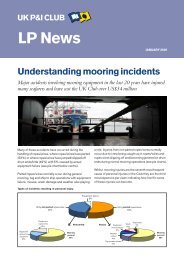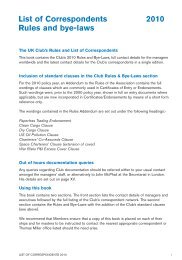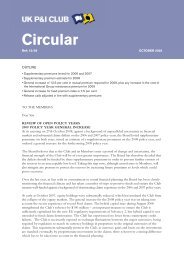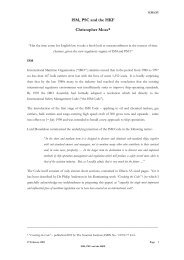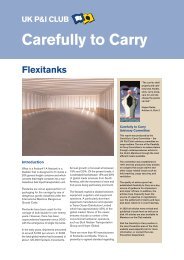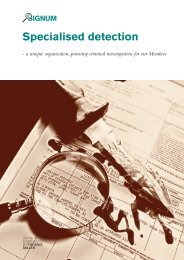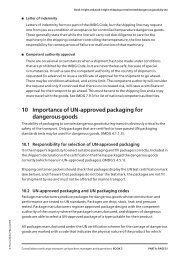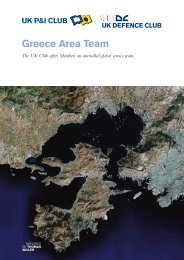Biofuels - UK P&I
Biofuels - UK P&I
Biofuels - UK P&I
Create successful ePaper yourself
Turn your PDF publications into a flip-book with our unique Google optimized e-Paper software.
The standard states that in “...those instances where<br />
the use of fuels containing FAME is being<br />
contemplated, it should be ensured that the ship’s<br />
storage, handling, treatment, service and machinery<br />
systems, together with any other machinery<br />
components (such as oily-water separator systems) are<br />
compatible with such a product.”<br />
The meaning of a ‘de minimis’ level is expanded upon<br />
in Annex A of the ISO 8217:2010 international<br />
Standard. It is noted that determining a ‘de minimis’<br />
level is not straightforward for a number of reasons,<br />
including the fact that there is no standardised<br />
analytical technique for detecting FAME materials in<br />
fuel oils and that, in most cases, sufficient data is not<br />
As we have mentioned previously, there has been<br />
significant experience worldwide in the use of ethanol<br />
as a fuel or fuel-additive. In the USA there has been<br />
over ten years successful use of gasoline containing up<br />
to 10% ethanol (E10), and in Brazil blends containing<br />
up to 85% to 100% ethanol (E85 and E100) are<br />
commonly used in flexible-fuel vehicles. The current<br />
European gasoline specification, EN228, allows up to<br />
5% ethanol by volume (E5).<br />
Whilst bioethanol can be produced from a number of<br />
raw materials, including sugar cane, corn and wheat,<br />
the raw materials do not impart the same variation in<br />
properties of the end product fuel as is the case with<br />
FAME. However, there are still a number of potential<br />
hazards for consideration.<br />
Bioethanol problems<br />
yet available with respect to the effects of FAME<br />
products on marine fuel systems. For the purposes of<br />
the International Standard, for the four grades of<br />
distillate fuel (DMX, DMA, DMZ & DMB when clear and<br />
bright) it is recommended that ‘de minimis’ be taken as<br />
“not exceeding approximately 0.1 volume %” when<br />
determined in accordance with test method EN 14078.<br />
For DMB when not clear and bright and for all<br />
categories of residual fuels, the standard notes that “...<br />
‘de minimis’ cannot be expressed in numerical terms<br />
since no test method with formal precision statement is<br />
currently available. Thus, it should be treated as<br />
contamination from the supply chain system.”<br />
Water contamination: Issues with regard to the<br />
carriage of bioethanol and bioethanol-gasoline blends<br />
include the potential for damaging water<br />
contamination. We mentioned previously that ethanol<br />
is hygroscopic and highly soluble in water. Small<br />
quantities of water can be dissolved in gasoline/<br />
bioethanol blends, but, dependent upon temperature<br />
and the gasoline/bioethanol blend ratio, there is a<br />
critical threshold level of water that can be dissolved.<br />
Once this threshold level has been exceeded,<br />
irreversible phase separation will occur whereby the<br />
water causes the ethanol to separate from the<br />
gasoline, forming an alcohol rich water/ethanol<br />
aqueous phase and an alcohol poor gasoline phase.<br />
The alcohol rich aqueous phase will collect at the<br />
bottom of the ship’s tank or storage tank. This phase is<br />
likely to be highly corrosive and will not be able to be<br />
used as fuel. In addition, if such phase separation does<br />
occur it is possible that the gasoline phase will be<br />
Bioethanol<br />
Bioethanol refers to ethanol produced by the<br />
fermentation of renewable sources of sugar or starch<br />
crops. Unlike FAME, bioethanol is a single chemical<br />
compound, the properties of which are well<br />
documented and understood. It is a volatile, colourless<br />
liquid which is miscible with water and also<br />
hygroscopic. Ethanol is the alcohol found in alcoholic<br />
beverages and is also commonly used as a solvent in<br />
perfumes, medicines and paints. However, the most<br />
common use for ethanol is as a fuel or fuel-additive.<br />
Ethanol for use as a fuel is generally dosed with a<br />
‘denaturant’ to render it unsuitable for human<br />
consumption.




